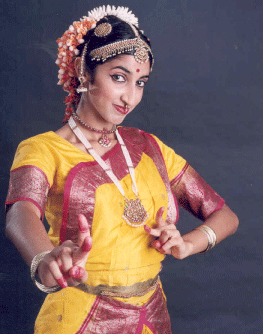Contribute
| Aparna Keshaviah Awarded Fulbright Grant |
Press Release
06/29/2006
Passed on over generations from teacher to student, Bharatanatyam has incrementally accrued its massive tradition. Yet much of that recognized tradition underwent several revisions, most recently in the early 20th century, when the term “Bharatanatyam†was invented. Today, the elements that delineate and define this Indian classical dance form are difficult to postulate. Aparna Keshaviah hypothesizes that inexact knowledge of the historical trajectories of modern-day Bharatanatyam has encouraged practitioners world-wide to formulate multiple traditions, each legitimizing their local form. If so, the diversification, and its tradition-bound rationale, should leave a statistical signature across India’s major dance schools.
Keshaviah, a Bharatanatyam teacher and performer based in Boston/ Brookline, MA, plans to use statistics to measure that diversity. She has been awarded a Fulbright Grant from the U.S. Department of State to conduct the research. Drawing on her training in statistics, she will use survey methodology to describe the nature and extent of variation in the execution of Bharatanatyam. Quantitative surveys administered to directors, teachers, and students of Bharatanatyam institutions will capture data on ubiquitous elements of the assumed dance tradition. Through statistical analysis of these data, Keshaviah’s research will help reveal a numerically defined landscape of Bharatanatyam, and thereby cultivate a more complete characterization of its varied form in the present day.
To date, there has been no systematic, analytic study of this kind, only open-ended interviews with notable practitioners. In an era when Bharatanatyam is increasingly globalized, charged discussions concerning the "traditional" versus "modern" overrun dance scholarship. Given the complete historical transformations and revisions that forged the dance seen today, these designations become arbitrary and problematic. Where on Bharatanatyam’s historical trajectory do we locate this “traditional†form? And accordingly, at what point do the widespread “stylistic differences†comprise a structural shift rather than a continuous evolution?
Precise knowledge of the range of Bharatanatyam’s manifestation will help address these issues through identification of discrete similarities and/or differences in practice across individuals, schools, and regions in India. By using a hybrid quantitative/qualitative approach, Keshaviah’s research will help dissect the diverse formulae of Bharatanatyam.
Aparna Keshaviah has studied Bharatanatyam for over 22 years and is an instructor at the Brookline Community Center for the Arts. She also holds a Master’s degree in Biostatistics from the Harvard School of Public Health and works at the Dana-Farber Cancer Institute. This fall, Aparna will depart for India, visiting the major cities in which the dance form is concentrated to undertake her research. Upon her return, she plans to publish her findings to share the fruits of her work with the dance and scholarly community. The results of her research will inform both her practice of and theoretical approach to Bharatanatyam.
You may also access this article through our web-site http://www.lokvani.com/
